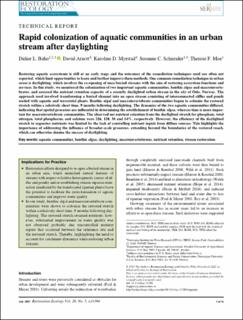| dc.description.abstract | Restoring aquatic ecosystems is still at an early stage and the outcomes of the remediation techniques used are often not reported, which limit opportunities to learn and further improve these methods. One common remediation technique in urban areas is daylighting, which involves the re-opening of once buried streams with the aim of restoring ecosystem functions and services. In this study, we monitored the colonization of two important aquatic communities, benthic algae and macroinvertebrates, and assessed the nutrient retention capacity of a recently daylighted urban stream in the city of Oslo, Norway. The approach used involved transforming a buried channel into an open stream consisting of interconnected riffles and ponds seeded with aquatic and terrestrial plants. Benthic algal and macroinvertebrate communities begun to colonize the restored stretch within a relatively short time, 9 months following daylighting. The dynamics of the two aquatic communities differed, indicating that spatial processes are influential in determining the establishment of benthic algae, whereas time is more important for macroinvertebrate communities. The observed net nutrient retention from the daylighted stretch for phosphate, total nitrogen, total phosphorus, and calcium were 226, 128, 38 and 14%, respectively. However, the efficiency of the daylighted stretch to sequester nutrients was limited by the lack of controlling nutrient inputs from diffuse sources. This highlights the importance of addressing the influence of broader-scale processes, extending beyond the boundaries of the restored reach, which can otherwise demise the success of daylighting. | |
